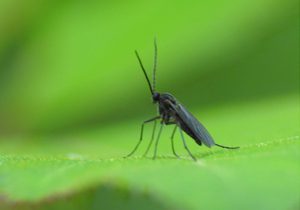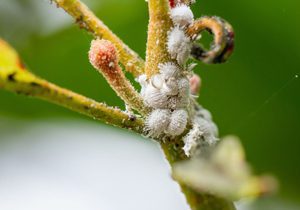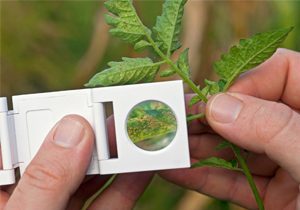Orchids are generally trouble-free plants, though if you’re an orchid grower, you’ll surely face plant care problems every once in a while.
The key to becoming a good orchid grower—and one who can keep their orchids thriving year-round—is to know how to prevent pests from invading your plant, identify what’s wrong with your orchid if it does show signs of pests, and how to quickly and efficiently get rid of those pests that do take up home in your plant.
When you know how to navigate pest situations, you’ll be able to save your plant, care for it, and nurse it back to health no matter the scenario.
Let’s take a look at 5 common orchid pests and how to identify, prevent, and rid your orchid of them.
Common Orchid Pest #1: Aphids
Aphids are soft-bodied insects that feed on plant sap and produce large amounts of sugary waste which appears on your plant as white specs. Often orchid growers notice aphid droppings before they notice the aphids themselves.
Aphids are very small bugs that you may, at first glance, overlook. They range in color and size, though they are commonly green, red, black, or yellow and no larger than a grain of salt.

Aphids typically appear in clusters, so look for them on your orchid’s flower buds, young shoots, and leaves.
How to remove aphids from your orchid: Mist your plant with soap and water spray. This knocks the aphids off your orchid and usually prevents the insects from returning. If this isn’t successful, the infestation is more severe. Try using a horticultural oil to coat the insects, kill them off, and prevent eggs from maturing.

Common Orchid Pest #2: Black Rot
Black rot is caused by a pathogen called Phytophthora cactorum, which thrives in moist, cool conditions. The pathogen spores invade the plant and encourage the breakdown of its vital root and stem systems.
While black rot can occur in a variety of orchids, Cattleya orchids are especially susceptible. It presents as sizable black spots on your orchid’s leaves that slowly spread.
Avoiding black rot in orchids is difficult, though the most common preventative measure is to avoid over-watering your plant. Make sure your orchid is in a pot that provides plenty of drainage and aeration to its potting mix. Dry conditions will prevent pathogen spores from invading and infecting your orchid.
How to save your orchid from black rot: If you notice black rot on your orchid, apply a fungicide as quickly as possible. While we recommend a commercial product to get the job done, you can try using lime or cinnamon powder to discourage black rot spread as well. Then use a pair of sharp shears to remove the infected stems and leaves and repot your orchid in a fresh, dry potting mix.
Common Orchid Pest #3: Fungus Gnats
Fungus gnats are long-legged, long-antennae flies with black bodies. While fungus gnats are unsightly, they’re usually only harmless nuisances.
Fungus gnats are in search of one thing: fungi. Female gnats lay eggs in moist soil so when the eggs hatch, the small maggots can feed on the fungus growing in the soil. So, if you see fungus gnats swarming your orchid, rest assured that they aren’t destroying your plant, but merely making use of the fungus in its soil.

To prevent fungus gnats in the first place, repot your orchid to refresh its decaying organic material with a new potting mix and avoid over-watering your plant.
How to remove fungus gnats from your orchid: Fortunately, fungus gnats are easy to remove. Simply purchase a standard sticky houseplant pest card, place it in your orchid’s pot, and scale back on your watering routine.

Common Orchid Pest #4: Mealybugs
Mealybugs are common pests for most houseplants, so they’re not particular about their hosts and will take up home in many orchid species.
They are scaled, unarmored insects that prefer warm, humid climates. At first glance, a mealybug infestation can look like small cotton masses on your orchid’s new buds, stems, and blooms.
If left untreated, a mealybug infestation can quickly get out of control, so it’s important to take action quickly.
How to remove mealybugs from your orchid: When possible, isolate infested plants from others to prevent the spread to other vulnerable plants. Because mealybugs tend to be invasive pests, it’s best to skip the home remedies and purchase an insecticide. Apply the treatment once every 10-14 days to ensure the infestation doesn’t reoccur.
Common Orchid Pest #5: Spider Mites
Spider mites are microscopic insects that are hard to detect—until they’ve done visible damage, that is.
Spider mites thrive in hot, dry climates, so if your orchid is in a sunny spot, it may be more susceptible to spider mites than an orchid positioned in low-light conditions.

If your plant has been infested with spider mites, it’ll have a silvery shine on the underside of its leaves. This indicates that your plant is losing sap and suffering. It’ll also boast tiny webs, where the spider mites catch prey.
How to remove spider mites from your orchid: Spray your plant with water to stun the mites and kill them off. If the infestation is particularly bad, mist your plant with a diluted mixture of soap and rubbing alcohol instead. Then carefully inspect your plant and destroy all webs to prevent the mites from taking up home in your plant again.
A Recap: 5 Common Orchid Pests and How to Prevent Them
There you have it! You’ve just learned the 5 most common orchid pests, how to prevent each pest from taking up home in your orchid, and how to get rid of them if they’ve already arrived.
Here’s a quick recap so you’re fully equipped to keep your plant happy, healthy, and pest-free.
- Aphids are very small insects that cluster around your orchid’s buds, leaves, and blooms. They’re easily identified by their white droppings that appear all over the plant. Use a soap and water spray to rid your orchid of aphids should they crop up.
- Black rot is a form of plant rot caused by pathogens. If you notice black spots on your orchid, take action right away. Apply a commercial fungicide to kill off existing pathogens. Then cut away dead stems and leaves and repot your plant with fresh potting mix.
- Fungus gnats are harmless insects that feed on microscopic fungus growing in your orchid’s potting mix. Invest in a small sticky bug trap and scale back on watering to remedy the infestation.
- Mealybugs are small armored insects that cluster on houseplants and eat their sap. Apply an insecticide if you see mealybugs on your plant, and be sure to reapply every 10 days or so until the mealybugs are gone.
- Spider mites are microscopic, so they’re hard to identify. Telltale signs of a spider mite infestation are silvery leaves and miniature webs in your orchid’s soil and along its leaves. Mist your plant with water and destroy all webs to prevent another infestation.
If you have any concerns about taking care of common orchid pests, join our Facebook community, where you’ll meet other orchid growers like yourself and get access to our exclusive orchid-growing tips and tricks.



